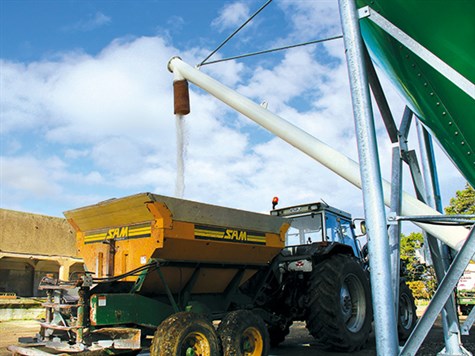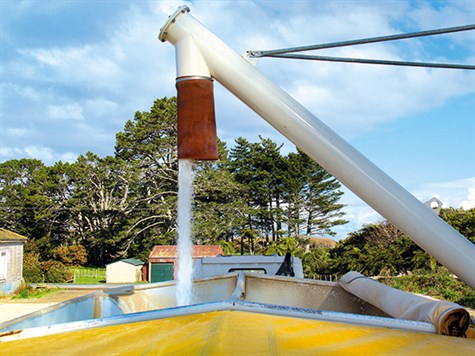Fieldays buyers' guide: Agri-Tech silo
 Agri-Fert worked with Agri-Tech to have these silos modified.
Agri-Fert worked with Agri-Tech to have these silos modified.

 Robust to withstand excessive weather and seismic loads.
Robust to withstand excessive weather and seismic loads.

 Remote-operated silos can be controlled with a USB-type key which would identify the customer and its use.
Remote-operated silos can be controlled with a USB-type key which would identify the customer and its use.

 Removable coverplate for emergency discharge.
Removable coverplate for emergency discharge.

 Heavy-duty load cells under each leg.
Heavy-duty load cells under each leg.

 Printer option to record each load removed.
Printer option to record each load removed.

 Computer control is unlimited and can be customised to suit each owner.
Computer control is unlimited and can be customised to suit each owner.

 Siemen motors with oil bath gearbox.
Siemen motors with oil bath gearbox.

 Camlock for blower trucks.
Camlock for blower trucks.

 With computer control of dispatch, farmers can use the silo 24/7.
With computer control of dispatch, farmers can use the silo 24/7.

 Screw capacity can be supplied to suit customers.
Screw capacity can be supplied to suit customers.


|
|
Agri-Fert worked with Agri-Tech to have these silos modified.
|

|
|
Robust to withstand excessive weather and seismic loads.
|

|
|
Remote-operated silos can be controlled with a USB-type key which would identify the customer and its use.
|

|
|
Removable coverplate for emergency discharge.
|

|
|
Heavy-duty load cells under each leg.
|

|
|
Printer option to record each load removed.
|

|
|
Computer control is unlimited and can be customised to suit each owner.
|

|
|
Siemen motors with oil bath gearbox.
|

|
|
Camlock for blower trucks.
|

|
|
With computer control of dispatch, farmers can use the silo 24/7.
|

|
|
Screw capacity can be supplied to suit customers.
|
There are generally two things that farmers wish for in life – the equipment to make their life easier, and the second is the ability to feed cattle to their full potential. Agri-Tech promises both.
So, how do feed and fertiliser applications from Italian silo manufacturers Agri-Tech help the farmer with their two wishes?
Well, it combines both wishes into a simple solution feed silo, which can be located at the shed to feed meal, PKE, or blends straight into the cowshed without having to start the tractor, load the wagon, load the bins etc.
You simply push the button and turn the dial up or down, depending on how much you want to give your cows, and job done.
These have another application, too, which is what I went to check out at the Ravensdown Mangatoki depot in Taranaki, where the 52m3 silo is used to hold around 40 tonnes of urea to help keep the farmers happy during times of high demand.
To give you a quick overview of the silo, here are some key features. The 52m3 silo has load cells on each of the four legs that contains a digital readout of the remaining material in the silo. It is made of fibreglass with heavy-duty bracing with a fixed auger for fast load out.
Scientific study: metal vs. fibreglass silos
Italian scientists carried out an independent test to measure the quality of feed conservation in both metal and fibreglass silos during winter and summer months. Both sets of silos were supplied by Agri-Tech, so it isn't a comparison between two rival companies, but simply of metal and fibreglass silos.

The study was carried out using pig meal in six silos with six tonnes of food in each and installed in pairs (ie. one metal with one fibreglass) to create the same environmental conditions regarding their exposure to the sun.
The silos were loaded to two-thirds their capacity and then were progressively emptied. Like filling the diesel tank on your tractor at night time to limit the condensation build up in the tank, the silo works in a very similar fashion – as the temperature in the silo heats and then cools, the moisture percentage in the air will change and can be harmful to feed quality.
Test results during the summer
- The fibreglass silos can withstand thermal fluctuations and control both the air and the feed temperature better than metal silos.
- In the fibreglass silos, instant, minimum, and maximum temperatures were better than in metal silos.
- The difference in max temperature recorded in the silo was 8°C higher in the metal silo, with the maxi temperature peaking at over 45°C.
- The temperature of feed in the upper part of silos has reached temperatures between 35°C and 45°C in the metal silos, while in the fibreglass silos the highest temperature never exceeded 35°C.
Test results during the winter
- During the winter months, the temperature of the fibreglass silo had the least significant variations in both the inside air temperature and the temperature of the stored feed bulk when compared to the metal silo.
- Over the 15 test weeks, the temperature variations in the fibreglass silo were 32-percent lower than the metal silo, which will help to retain the quality of the feed if it's required to sit in the silo for extended periods before being fed out.
- The fibreglass silo was superior in every respect when maintaining a temperate climate for stored feed.
Agri-Tech construction features
- The silos have a glass-smooth interior (which prevents feed sticking and allows for easy removal of bulk material) and don't have any issues shelving on the corrugations often found on metal silos.
- Inspection hatches can be assembled in the hoppers as an option.
- Less bolts in the main body, which means no water seepage in the bin and no risk of feed degradation.
- Special watertight edge around the central joint of the silo to facilitate the sliding of rainwater.
- These particular models come direct from the factory in a modular design (20 pieces in a container), which can then be assembled on site.
Auger
The auger is manufactured by Scutti and also imported by Agri-Fert equipment, offering a large range of options of screw augers with differing sizes and capacities, as well as flexible augers for carrying feed into cowsheds.
Electronic scales
Our test silo didn't have the Agri-Tech weigh cells attached because it wasn't certified for commercial use in New Zealand at the time of construction. However, they have passed the test and now they can be.
Agri-Tech's silo weighing systems consist of three or four stainless steel load cells and you can have the choice of three digital weight display systems. The digital display shows the quantity of product stored in the silo and can be wired with a motor operating an extraction auger, where you can preset a certain quantity of product to be.
In addition, this system automatically memorises the daily loads and unloads of the stored product with up to 400 operations. It can manage groups of silos and generate reports about weights, loads, unloads, and daily consumptions from one or several silos, as well as calculations on the average feed consumption of each animal on the farm — think of it as the Protrack of feed distribution.

The verdict
Palletised feed and fertiliser are probably two of the most expensive 'brought in' products for farmers. Getting the highest return on investment has to be the highest priority.
Independent studies have shown that fibreglass doesn't suffer temperature fluctuations as drastically as its galvanised metal counterpart. This is good news for feed storage and will help keep pesky urea from sucking additional moisture and condensation into the silo, particularly if stored for extended periods.
On top of this, it doesn't rust – the frame is galvanised and heavy bracing will help it stand up to the elements. When fitted with a high output auger and intelligent weigh system, it won't deteriorate on you, nor will it let your expensive product cause you any grief when it's time to use it.
For more information contact Agri-Fert on 022 079 2811 or email gary@indmach.co.nz
Pros
- Smooth interior for easy material flow
- Bottom auger allows fast unloading
- Fibreglass silos are ideal in fertiliser applications as they will not rust
- The digital readout allows you to immediately check quantity of stored product
- Weigh cells allow exact weights to be programmed into the computer, automatically shutting off the auger once ideal weight is reached
- Computer-controlled options of weighing, batching, feed consumption etc. and telemetric ability to download to a PC
- Can be erected on site
- Strong bracing will handle New Zealand's often wild weather and seismic loads
Cons
- Filling time is a major drawback as 28 tonnes of urea will take over an hour to load the silo itself
- Moisture can be blown into the silo by the blower trucks when loading material such as urea, which can then create problems when augering out.
For the latest reviews of farm machinery, subscribe to Farm Trader magazine here.
Keep up to date in the industry by signing up to Farm Trader's free newsletter or liking us on Facebook



.jpg)




.jpg)
.jpg)
.jpg)

